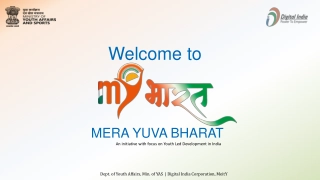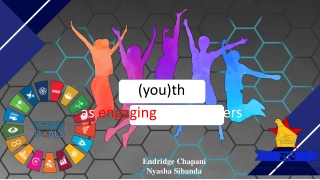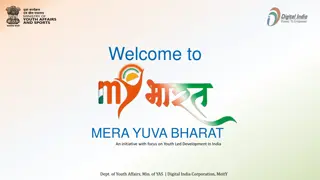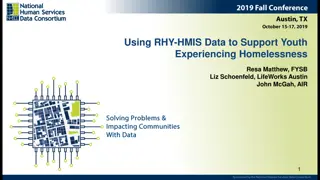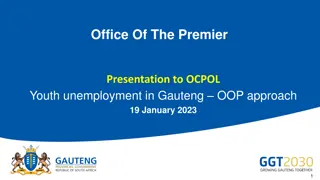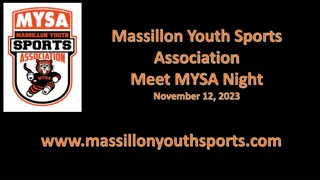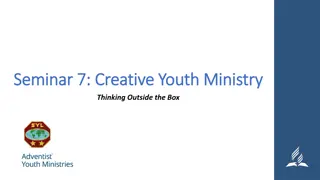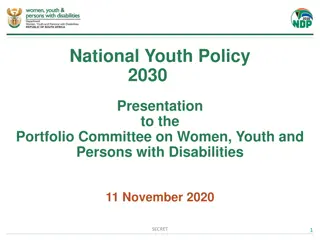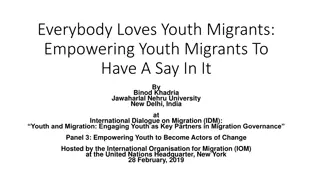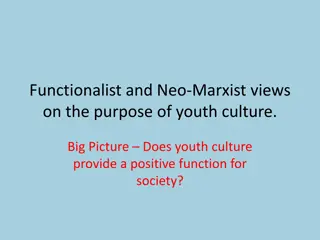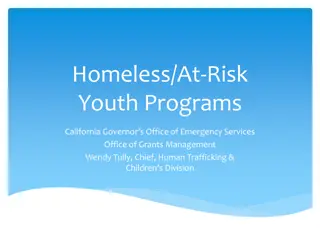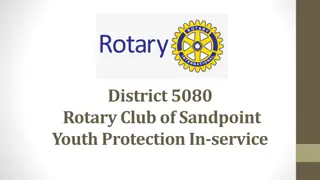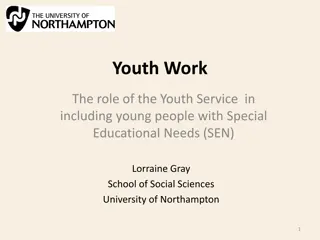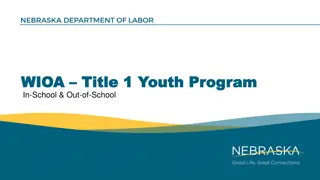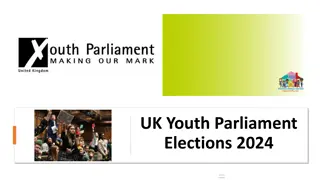
Workshop on Youth Assessment Strategies in Agriculture Education
Join Dr. Hui-Hui Wang and Dr. Neil Knobloch in this engaging workshop focused on assessing learning outcomes for youth in Purdue Agriculture. Explore strategies, resources, and activities to enhance learning assessment techniques.
Download Presentation

Please find below an Image/Link to download the presentation.
The content on the website is provided AS IS for your information and personal use only. It may not be sold, licensed, or shared on other websites without obtaining consent from the author. If you encounter any issues during the download, it is possible that the publisher has removed the file from their server.
You are allowed to download the files provided on this website for personal or commercial use, subject to the condition that they are used lawfully. All files are the property of their respective owners.
The content on the website is provided AS IS for your information and personal use only. It may not be sold, licensed, or shared on other websites without obtaining consent from the author.
E N D
Presentation Transcript
Youth Assessment Strategies Purdue Agriculture PK-12 Engagement Workshop Dr. Hui-Hui Wang & Dr. Neil Knobloch 11/10/15
Agenda Review the previous workshop Public Audiences / Youth Learning Outcomes Assessment Strategies Resources
Activity: Putting The Puzzle Together Try to put the cards into order from broadest to most specific and decide where learning outcomes fit
Where do learning outcomes fit? K K- -12 Curriculum 12 Curriculum Years Learning Outcomes Learning Standards Syllabus Syllabus Months Course Goals Unit Plan Unit Plan Weeks Unit Objectives Lesson Plan Lesson Plan Days Learning Objectives
Assessing Learning Outcomes Levels of learning outcomes and assessment Institution Program Course Learner This workshop focuses on learner learning outcomes and assessment
Learning Outcomes What are potential learning outcomes? How to write a good potential learning outcomes statement? When do you write your public audiences (youth) learning outcomes?
Backward Design Learning Activities Learning Outcomes Evidences 7
Activity: Identify outcomes Watch the video, brainstorm with your team and come up with your strategies to assess learning outcomes. Target Audience Outcome Category Learning Outcome https://www.youtube.com/watch?v=yGxSFbhtjZo Target Audience Outcome Category Learning Outcome Possible Evidences Strategies (Methods)
Activity: What are your strategies? Using the provided resources, work with your team to come up with specific strategies (methods) to assess engagement and interest Target Audiences Identify Learning Outcomes Possible Evidences Strategies (Methods) 12~18 years old youth Engagement & Interest Time spent in activity Time & Tracking Observation Log
What Strategies Did You Choose? Why? Questions How would you make the assessment meaningful and assess what matters? What assessments are appropriate for the targeted outcome and audience, and would provide evidences of learning? How much time do you have? What resource and support do you have? 1. 2.
Types of Assessment Methods Survey (one shot) Pre-post test Observation Interview Work sample (written materials) Advantages Disadvantages Others
Assessment Methods Quantitative Quantitative Numerical data collection Findings can possibly be generalized to broader populations Qualitative Qualitative Multiple Methods Multiple Methods Use both quantitative and qualitative Can be useful to triangulate and provide more than one perspective Definition Descriptive data collection Focus more on an in- depth understanding that individual have constructed about their experiences in a particular context and point in time May not be generalizing findings beyond the original inquiry Advantages Disadvantages May not tell you why ; Subjects may misinterpreted questions Surveys, questionnaires, standardized pre-and post-test instruments How the two methods work separately and together? Examples Interviews, focus groups, observations, analysis of written materials Observation protocol and rubric
Questionnaire (Survey) Tips 1.What questionnaire already exists? Can a questionnaire be modified to measure targeted outcomes in this context? 2.Keep it simple and manageable. 3.At the beginning of the questionnaire, briefly tell the purpose of the study. 4.How the language in a questionnaire is phrased can influence the responses of the subject. 5.Test your questions beforehand.
Observation Checklists An observation checklist identifies learning objectives and behaviors, and are used to determine whether a learner exhibits the behaviors or skills listed at a specific moment of time. 1. Listing target behaviors. 2. Arranging the desired actions. 3. Creating procedures for checking each action as it occurs. Tips
Interview The goal of a well-conducted interview is to elicit a participant s responses in ways that avoid the imposition of bias on the part of the interviewer. Tips 1.Don t ask things unless you are sure you require the answers. 2.Arrange your questions that the most personal (sensitive) questions come last. 3.Ask about only one item at a time
Work Samples and Portfolios A systematic collection of authentic learner s work placed in portfolio. It can create a timeline of progress that reflects learners success. Tips 1.Determine big ideas and concepts that you like to monitor and analyze over time. 2.Determine type of a learner s work that will be collected, such as journal, drawing, videotapes, and/or photos.
Limitations of this Workshop ( possible topics for Future Workshops) Direct- and indirect-measures Validity and reliability Data analysis Quantitative Qualitative How to conduct observations & interviews Best practices & pitfalls Specific protocols Others? ___________, ___________, ___________ Please share on the workshop evaluation
Resources From soft skills to hard data http://forumfyi.org/content/soft-skills-hard-data- Assessment Tools in Informal Science http://www.pearweb.org/atis/dashboard/index Informal Science Evaluation Resources http://informalscience.org/evaluation Dimensions of Success http://www.pearweb.org/tools/dos.html Dimensions of Success Video https://www.youtube.com/watch?v=Gy7Vl5ZrvKw&feature=youtu.be Youth Involvement and Engagement Assessment Tool http://youth.gov/docs/pyd_AssessmentTool.pdf Defining Youth Outcomes for STEM Learning in Afterschool http://www.afterschoolalliance.org/STEM_Outcomes_2013.pdf A shared Vision for Youth: Common Outcomes and Indicators http://www.nationalassembly.org/Knowledge/documents/NCYCommonOutcomes.pdf
Choosing Assessment Tools Don t get overwhelmed by the process! Keep things feasible and manageable. An assessment tool may be used to assess more than one learning outcome. Amount of data Amount of data Subjects Subjects comfort comfort Ease of Ease of transcription transcription Affordability Affordability Check sheets Medium High High High Event recorder High Medium to low Medium to high Low to medium Audio tape High Medium Medium Medium Videotape Highest Low Low Low Diamond, J. (1982). Ethology in museums: Understanding the learning process. Roundtable Reports, 7(4), 13-15.

